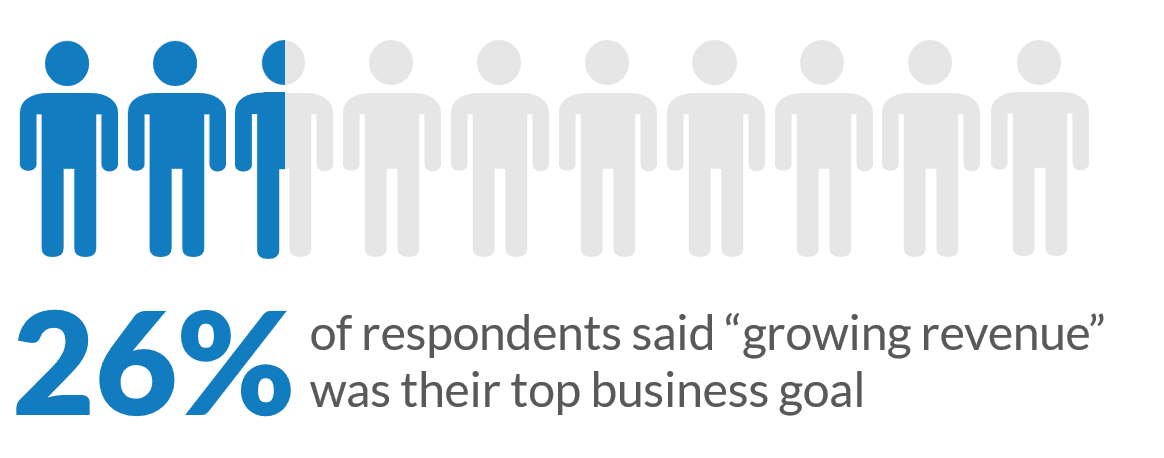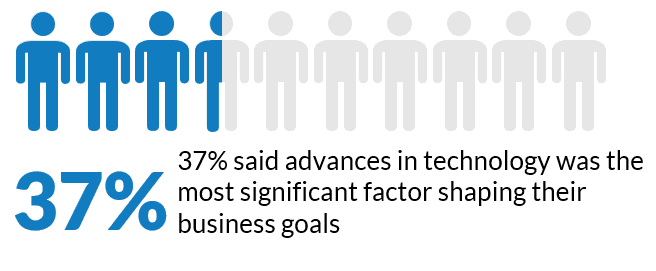To all the technology marketers out there, here's a question for you:
How much would you pay to get your hands on a crystal ball that tells you exactly what your potential leads want to buy in the next few years?
Most likely, a lot.
The challenge of creating insightful, moving, industry-changing marketing campaigns is especially difficult in the technology industry because of the rapid rate of change.
How can software vendors catch the eye of leads when it seems like there are new shiny tech innovations every month?
To successfully market to small and midsize businesses (SMBs) in 2019, software marketers need insights into the technology considerations, business goals, and investment activities of SMBs.

To get those insights, Gartner Digital Markets surveyed SMBs on their technology investments and goal-setting behaviors, which we'll overview in this piece.
We also provide suggestions for software vendors and their marketing teams to create marketing campaigns and develop product features that address SMB goals and expectations identified in this research.
These recommendations should drive your high-level marketing strategy and planning for 2019 to 2020.
Survey methodology
In June 2017, 699 individuals across 14 industries answered business technology-related questions for a Gartner Digital Markets survey. All of the respondents were from small to midsize businesses with fewer than 499 employees and report less than $100 million in annual revenue.
Below are four key takeaways from that survey data, with the goal of helping you create or reformat your existing marketing campaigns for small and midsize business buyers in 2019.
1. Shape your product marketing around SMB goals
If you can align your product marketing with your customers' goals, your product will be as natural a fit for them as a tailored suit.
But first, you need to know what your customers' goals are.
We asked small and midsize businesses what their top business goals are, and the answer was expected:

179 out of 699 SMB respondents identified “grow revenue" as their top business goal (Gartner Digital Markets)
"Grow revenue" was, overwhelmingly, the top goal for small and midsize businesses surveyed, with 26% of the 699 respondents identifying it as their top goal.
What does this mean for your marketing campaign for your product?
If you provide software that saves a business time, they will in turn, save money. After all, time is money.
A marketing campaign that identifies the aspects of the software that increase efficiency or usability, thereby saving money and increasing revenue, will be more likely to make it onto buyers' short lists. That means you should highlight an accessible user experience (UX) and user interface (UI).
You can shape your message like this: Every minute your customers spend learning how to use a clunky product is a minute not spent generating potential revenue streams.
SMB processes and workflows are often unique and come with challenges that enterprise-level consumers don't have. If you have an intuitive product design that makes these processes easier, tell potential small and midsize business customers how your product is built to make their lives easier.
KEY TAKEAWAY: Design your marketing campaign to include examples of how your product is either easier to use than your competitors, or present an "ease of use" case study to your potential buyers.
2. Set goals: Turn SMB strategies into your marketing strengths
Forty-one percent of 699 respondents named “competition in your industry" as a significant factor shaping their business goals.
2019 marketing campaigns should address how your technology can help SMBs overcome their competition, or, at the very least, point out that you recognize the level of competition they are experiencing.
That's not the only opportunity for software marketers, however. While “competition in your industry" was cited by the largest number of small and midsize businesses, 37% of SMBs cited “advances in technology" as the top factor shaping their business goals.

Thirty-seven percent (261) of 699 small and midsize businesses surveyed cited “advances in tech" as the most significant factor shaping their business goals (Gartner Digital Markets)
What does this mean for your marketing? If you can highlight the ways in which your product is on the cutting edge of the newest advances, you're likely to put potential customers in a good head space, and put at least some of their fears to bed.
A marketing campaign that assures customers they're taking advantage of something new, that could also put them at the head of their industry, is a great way to get a lot of business.
KEY TAKEAWAY: Increase your software solution's sales by creating marketing campaigns that address the goal-setting strategies of SMBs: competition and advances in technology.
3. Plan ahead: SMBs want cutting-edge technologies
George Jessel said in 1941: “Give people what they want and they'll come to see it."
It's an old show business saying that still works in marketing: If you give them what they expect with a small surprise, your product will sell.
SMBs already know (kind of) what they want. Software providers just need to put a little pizzazz in their offerings.
The pizzazz is cutting-edge, newsworthy technology features.
SMBs in disparate industries are planning on cutting-edge technologies significantly impacting their businesses in the next one to two years:

Snapshot of six disparate industries and the technologies respondents indicated they thought would significantly impact their businesses in the next one to two years (Gartner Digital Markets)
To take advantage of the future-facing mindset of SMBs, software providers should look at offering features with or solutions for:
3D printing
Artificial intelligence (AI) and machine learning (ML)
Autonomous vehicle functionality
Blockchain
Chatbot functionality
Conversational user interfaces
Drones
Virtual and augmented reality
Wearables
To be clear: Software solution providers don't need to go to their product team and completely overhaul their offerings to meet all of these technology pipe dreams. The idea here is to play to your already existing strengths with your marketing message.
For instance, if a FSM solution provider has software that can easily integrate with a client's desire to use wearables in their workforce, provide a marketing message that highlights this capability.
KEY TAKEAWAY: Software solution marketers can win over SMB buyers by leading the conversation on cutting-edge technologies. They should plan marketing campaigns focused on the aforementioned topics that buyers are predicting will change their businesses in the next two years.
4. Help your buyers identify the right technology: yours
A majority (54%) of the 699 respondents indicated that identifying the right technology was the top challenge that their organization faces when planning to invest in new technology.
Not funding (34%). Not in-house skills (34%). Not disruption to current business practices (28%).

368 of 699 respondents indicated that identifying the right technology was the top challenge they face when planning to invest in new technology (Gartner Digital Markets)
How can software providers make identifying the right technology easier for SMBs?
Get your product in front of your potential customers faster.
Software providers with great digital footprints are already using SEO best practices and creating stellar content, but that's only half of the process to being found online.
Optimizing for SEO isn't enough anymore; relying on your product to show up in search results is only part of the marketing picture. You need to have your software show up in relevant content outside of your home site to show that industry experts are using and loving your product.
To do that, you need to list your offering on software directories, as well as reach out to industry thought leaders to have them use and review your product for their audiences.
Build potential customer's trust in your offering.
In the digital age, trust is built by user reviews. The logic behind user reviews is valid: If someone else used a product and gave it a positive review, users hypothesize that they will most likely have a positive experience as well.
Marketers get the added benefit of an SEO lift when positive reviews of their product show up on Google and other search platforms, so reviews are an all-around win.
KEY TAKEAWAY: Make it easier for customers to find and trust your offerings by listing your product(s) on websites such as Capterra, Software Advice and GetApp. These digital software directories allow your potential clients to easily filter by the features they need and provide user reviews that builds their trust in your brand faster.
Technology vendor takeaways
You'll want to keep an eye on your individual markets for more nuanced messaging to potential clients.
THE KEY TAKEAWAYS FOR TECHNOLOGY VENDORS ARE:
Highlight how your product is easy to use, therefore saving time that can be devoted to more important SMB activities that ultimately lead to increased revenue.
Address the worries of SMBs for 2019: competition and advances in technology.
Lead the conversation on cutting-edge technologies because SMBs are already thinking about how they will change their strategies to incorporate new tech.
Make it easier to find your software by including your product on a user reviews-centric platform such as Capterra, GetApp, or Software Advice.
Want to learn more about small and midsize business technology trends? Read on: